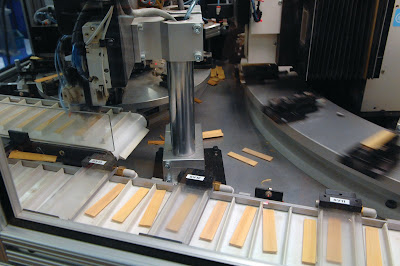This summer I was given the opportunity to take a tour of the Rico factory located outside Los Angeles. The staff was very kind and knowledgeable and they led me on a great tour including the history of Rico, the cane growing process, and allowing me to witness the making of the reeds.
The process all starts at Rico's plantations, one located in France and another in Argentina. There they grow a specific, musically-suited cane known as Arundo donax from which will be formed all of Rico's cuts and styles.
The weather at the plantations is ideal for the cane and meets the requirements for moisture, cold periods, and sun exposure. All in all, it takes anywhere from two to four years for a stalk of cane to mature. Once this period is up, cane poles that do not meet the size requirements are removed by hand.
The cane is harvested in the winter while the cane is dormant. The harvest period lasts for 2-3 months and involves de-husking, sunning, drying, sawing, and storage.
A worker de-husks a stalk of Arundo donax. All of the "branches" are thrown out.
The cane poles are dried thoroughly to achieve their golden color. Rico is pioneering new ways to properly dry and sun the reeds. Their goals are premium quality cane and unparalleled consistency.
Here a worker checks the cane to be sure that it is fully dried. Only cane that has been aged properly will be shipped to the factory.
The nodes of the cane are then cut off, leaving small segments behind. These segments are then bagged and shipped to Rico's factory in Sun Valley, California.
Upon arriving in the factory the tubes are inspected and sorted by diameter and wall thickness before being split lengthwise into fourths. They are then fed into their respective machines to begin the reed-making process.
The first machine sands down the sides of the cane producing a basic reed blank. All reeds are checked by the machine for proper measurements. Those not within the accepted range are removed to either be re-sanded or discarded.
After being sanded, the blanks are then fed into another machine which cuts the vamp into the reed. At this point the product is beginning to look familiar.
The reeds then pass through color video inspection in order to detect any visible flaws in the cane. Another series of measurements is also taken to make sure they meet Rico's standards. The blanks are then sorted by strength into various boxes to continue on to their respective finishing stations.
Next, machines with specially made diamond cutters are used to cut the reeds, one at a time. The diamond cutters provide extreme consistency in the cut, as they do not dull quickly like the metal cutters used by other makers.
Here are the reeds fresh out of the cutter. After this they will go on to be measured and then packaged.
The reeds that come out of the cutter are constantly being measured for consistency and proper shape using points all along the reed. Employees keep a constant eye on the measurements, allowing them to compensate for any changes in either the cane or the machines.
Rico also has full-time musicians on staff to play-test finished reeds from each batch and offer feedback. Rico understands there are things that only a musician can feel from a reed and this helps them to produce a better product.
The finished reeds are then put into their plastic cases by a machine at the next station. After this they are grouped into tens and then pushed into their boxes. All of the boxes are weighed before being sealed. They do this to be sure that each customer gets the right amount of reeds. If an anomaly is detected, an employee checks the box before putting it back on the line. After this they are sealed in plastic and then shipped to the warehouse.
Below is some reed art that was displayed in the entrance of the factory. It also sums up the reed-making process pretty well.
 |
| 1. Tubes of cane arrive at the factory. |
 |
| 2. The tubes are then split into fourths. |
 |
| 3. The fourths are sanded and a preliminary cut it made. |
 |
| 4. The reeds are fully shaped, producing a finished product. |
 |
| 5. Reeds are placed into cases before being boxed and shipped. |
The tour was amazing and so were the people I met there. They are such incredibly passionate people who care about their craft deeply and are constantly looking to produce better products. It was inspiring and fascinating to see what it takes to produce that little piece of cane which is absolutely necessary to everything we do as clarinetists. They also have some new things in the works, but I am sworn to secrecy.
Special thanks to everyone at the Sun Valley Rico Factory. Also, thanks to Trish Johnson, for helping me along and providing me with many of the pictures in this post, and to Josh Redman, for his help in scheduling the tour and his all around nice-ness.
And if you haven't seen this video already, here it is.















